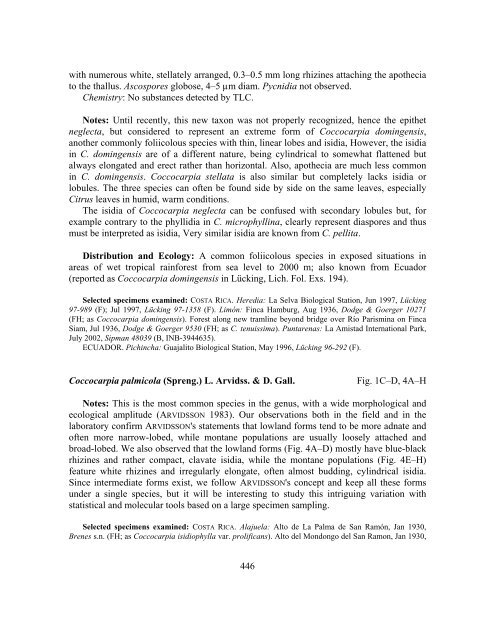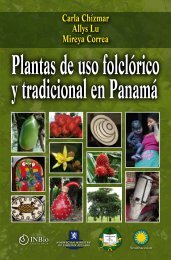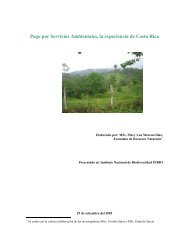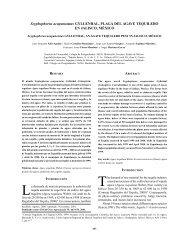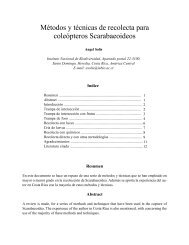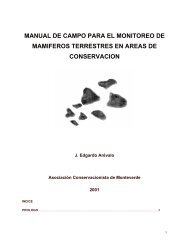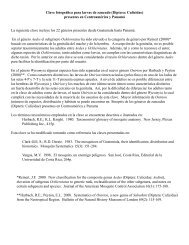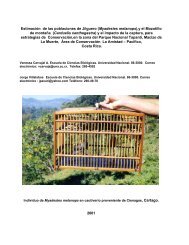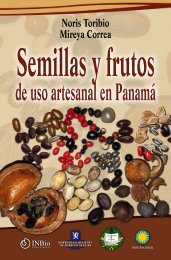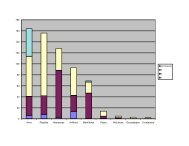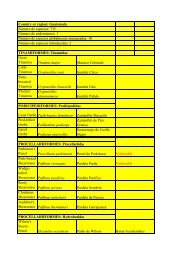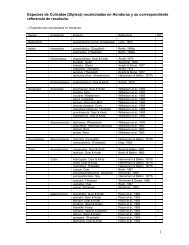with numerous white, stellately arranged, 0.3–0.5 mm long rhizines attaching <strong>the</strong> apo<strong>the</strong>cia to <strong>the</strong> thallus. Ascospores globose, 4–5 µm diam. Pycnidia not observed. Chemistry: No substances detected by TLC. Notes: Until recently, this new taxon was not properly recognized, hence <strong>the</strong> epi<strong>the</strong>t neglecta, but considered to represent an extreme form of <strong>Coccocarpia</strong> domingensis, ano<strong>the</strong>r commonly foliicolous species with thin, linear lobes and isidia, However, <strong>the</strong> isidia in C. domingensis are of a different nature, being cylindrical to somewhat flattened but always elongated and erect ra<strong>the</strong>r than horizontal. Also, apo<strong>the</strong>cia are much less common in C. domingensis. <strong>Coccocarpia</strong> stellata is also similar but completely lacks isidia or lobules. The three species can often be found side by side on <strong>the</strong> same leaves, especially Citrus leaves in humid, warm conditions. The isidia of <strong>Coccocarpia</strong> neglecta can be confused with secondary lobules but, for example contrary to <strong>the</strong> phyllidia in C. microphyllina, clearly represent diaspores and thus must be interpreted as isidia, Very similar isidia are known from C. pellita. Distribution and Ecology: A common foliicolous species in exposed situations in areas of wet tropical rainforest from sea level to 2000 m; also known from Ecuador (reported as <strong>Coccocarpia</strong> domingensis in Lücking, Lich. Fol. Exs. 194). Selected specimens examined: COSTA RICA. Heredia: La Selva Biological Station, Jun 1997, Lücking 97-989 (F); Jul 1997, Lücking 97-1358 (F). Limón: Finca Hamburg, Aug 1936, Dodge & Goerger 10271 (FH; as <strong>Coccocarpia</strong> domingensis). Forest along new tramline beyond bridge over Río Parismina on Finca Siam, Jul 1936, Dodge & Goerger 9530 (FH; as C. tenuissima). Puntarenas: La Amistad International Park, July 2002, Sipman 48039 (B, INB-3944635). ECUADOR. Pichincha: Guajalito Biological Station, May 1996, Lücking 96-292 (F). <strong>Coccocarpia</strong> palmicola (Spreng.) L. Arvidss. & D. Gall. Fig. 1C–D, 4A–H Notes: This is <strong>the</strong> most common species in <strong>the</strong> <strong>genus</strong>, with a wide morphological and ecological amplitude (ARVIDSSON 1983). Our observations both in <strong>the</strong> field and in <strong>the</strong> laboratory confirm ARVIDSSON's statements that lowland forms tend to be more adnate and often more narrow-lobed, while montane populations are usually loosely attached and broad-lobed. We also observed that <strong>the</strong> lowland forms (Fig. 4A–D) mostly have blue-black rhizines and ra<strong>the</strong>r compact, clavate isidia, while <strong>the</strong> montane populations (Fig. 4E–H) feature white rhizines and irregularly elongate, often almost budding, cylindrical isidia. Since intermediate forms exist, we follow ARVIDSSON's concept and keep all <strong>the</strong>se forms under a single species, but it will be interesting to study this intriguing variation with statistical and molecular tools based on a large specimen sampling. Selected specimens examined: COSTA RICA. Alajuela: Alto de La Palma de San Ramón, Jan 1930, Brenes s.n. (FH; as <strong>Coccocarpia</strong> isidiophylla var. prolificans). Alto del Mondongo del San Ramon, Jan 1930, 446
Brenes s.n. (FH; as C. cronia). Cerros de Pata de Gallo a San Rafael de San Ramón, Dec 1929, Brenes 215 (FH; as C. isidiophylla var. granulosa). La Palma de San Ramón, Oct 1929, Brenes 104 (FH; as C. cronia var. isidiophylla). San Pedro de San Ramón, Feb 1930, Brenes 459 (FH; as C. isidiophylla var. granulosa). Volcán Poás, Puente del Río Poás, Sep 1950, Dodge s.n. (FH; as C. cronia var. isidiophylla). Vicinity of Los Chiles, Río Frio, Aug 1949, Holm & Iltis 1506 (FH; as C. cronia). Volcán Tenorio National Park, Mar 2004, Aptroot 60418 (ABL, INB-3963861). Lücking 17215 (F, INB-4004852), 17252d (CR, F, INB-4004883, USJ), Nelsen 3760 (INB-4031204, WIS), 3773 (INB-4031205, WIS), Sipman 51770 (B, INB-4031206), Trest 1539 (INB-4031207), 1553b (INB-4031208). Cartago: Cangreja village, Oct 2002, Lizano et al. 49 (CR, INB, USJ). CATIE agricultural research centre near Turrialba, Nov 1988, Sipman & Döbbeler 42392 (CR). Cerro Carpintera, Nov 1929, Dodge & Thomas 4763 (FH; as C. cronia var. isidiosa). Finca Coliblanco, Oct 1929, Dodge s.n. (FH; as C. cronia). Hills S of Agua Caliente, Mar 1930, Dodge & Thomas 7087 (FH; as C. cronia var. isidiophylla). Paraiso village, Jul 2002, Lücking 15441c (INB-3980085). Río Macho village, Apr 2003, Grube 11764 (CR, GZU), Trest 1427b (INB-4031209), 1428a (INB-4031210, WIS). Santiago, May 1930, Dodge 8054 (FH; as C. isidiophylla var. granulosa). Tapantí National Park, Apr 2003, Lücking 16562 (INB-4002568). Guanacaste: Along Río Liberia near Hacienda Santamaria, Jan 1930, Dodge & Thomas 8055 (FH; as C. isidiophylla var. granulosa). Barra Honda National Park, Mar 2004, Aptroot 60825 (ABL, INB-4020489), 60845 (ABL, INB-4020712), Trest 1606f (INB-4031211). Hacienda Santamaría, Jan 1930, Dodge & Thomas 6987 (FH; as C. cronia var. furfuracea), 6900 (FH; as C. cronia var. isidiosa). Lomas de Barbudal Biological Reserve, Mar 2003, Trest 1345a (GZU), Trest 1346c (CR, WIS), Will-Wolf 12529d (WIS). Monte Alto Forest Reserve, Mar 2004, Aptroot 60787 (ABL, INB-4020406). NE of Tilaran, Atlantic slope, Feb 1930, Dodge & Thomas 6556 (FH; as C. isidiophylla var. granulosa). Palo Verde National Park, Mar 2003, Sipman 51008a (B, INB-3987468), 51021 (B, INB-3987487), Will-Wolf 12511a (CR, WIS). S of Liberia, Jan 1930, Dodge & Thomas 6582 (FH; as C. cronia var. granulosa). Valley below Tilaran, Feb 1930, Dodge & Thomas 8256 (FH; as C. cronia var. isidiophylla). Volcán Tenorio National Park, Mar 2004, Will-Wolf 12792c (INB-4031212). Heredia: Carrizal village, Jul 2002, Sipman 48370 (B, INB-3987180). Cerro Central de Zurqui, Dec 1929, Dodge et al. 6089 (FH; as C. cronia var. isidiophylla). La Selva Protection Zone, Jun 2002, Lücking 15022b (F, INB-3932449); Oct 2002, Lücking 16002f (F). Volcán Barva, March 1985, Sipman 20613 (B, CR). Limón: Braulio Carrillo National Park, Mar 2003, Grube 11228 (GZU). Finca Castilla, Jul 1936, Dodge & Goerger 9172 (FH; as C. cronia var. granulosa). Gandoca- Manzanillo Wildlife Refuge, Mar 2004, Lücking 17086g (CR, USJ), 17093c (F), 17095b (CR), 17102h (INB), Sipman 51691 (B, IBN), 51691a (B, INB). Hamburg Farm, Mar 1930, Dodge & Neverman 7401 (FH; as C. albida). Cerere Biological Reserve, Mar 2004, Trest 1510b (INB), Will-Wolf 12719g (INB). Puntarenas: Corcovado National Park, Apr 2003, Sipman 51152b (B, CR), Will-Wolf 12575e (INB). Floodplain of Río Sándalo, peninsula of Osa, Sep 1936, Dodge & Goerger 10426 (FH; as C. cronia var. granulosa), 10164 (FH; as C. cronia var. isidiophylla), 10162 (FH; as C. cronia var. isidiophylla). Floodplain of Río Terrones, peninsula of Osa, Aug 1936, Dodge & Goerger 10331 (FH; as C. cronia var. isidiophylla). La Amistad International Park, Jun 2002, Lücking 15186a (F, INB-3975917), 15199a (CR, F, INB-3976003), 15307 (INB-3976366). Las Cruces Biological Station, Oct 2004, Sipman 53292 (B, INB- 3993697). Las Tablas Protection Zone, Jun 2002, Lücking 15136a (INB-3974770), Sipman 47948b (B, INB- 3924211), Trest 488 (INB). San José: Along road from San Jerónimo to Alto La Palma, Nov 1988, Sipman et al. 41583 (B, CR). Cerro de la Muerte, along Panamerican Highway, March 1985, Sipman & Chaverri 20744 (B, CR). Finca Guayabillos, Jul 1936, Dodge & Goerger 9240 (FH; as C. cronia var. granulosa). Forest along Río Paquita, Aug 1936, Dodge & Goerger 9759 (FH; as C. cronia var. lividorufa), 9757 (FH). Los Santos Forest Reserve, Apr 2003, Grube 11804 (GZU, USJ); Jul 2002, Lücking 15551 (F), Trest 640a (INB- 4031273). N of Turrúcares, Mar 1930, Dodge & Thomas s.n. (FH; as C. pellita var. parmelioides). Valley of San Gerardo de Dota, July 1989, Wijtzes 1090 (B). <strong>Coccocarpia</strong> pellita (Ach.) Müll. Arg. Fig. 1E–F 447


